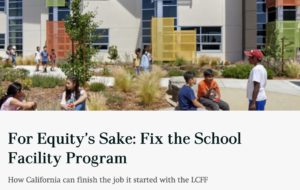Equitable School Facilities
Today’s challenges require our public school facilities to meet several demands:
Ensuring education quality and equity
Promoting community and racial justice
Planning for the expansion of early education
Supporting community health and well-being
Meeting climate resilience and mitigation goals
Why School Facility Infrastructure Matters: Equity & Adequacy
Every day, millions of elementary and secondary school children in the U.S. attend public schools with deteriorated and obsolete facilities that undermine achievement, harm health, and are not climate resilient.
The conditions and qualities of school facility infrastructure matter to children, families, and communities. School facility inequity was a major complaint in the 1954 Brown v Board of Education case and remains a problem in communities across America today. Decades of research confirm that the conditions and qualities of school facilities can positively or negatively impact students, teachers, and overall academic achievement. The facilities are not the most important aspect of school quality, but they are foundational.
Our work is informed by four core beliefs:
- School facility quality has a clear and measurable impact on student learning, staff job satisfaction, the health and well being of staff and students, and community quality of life.
- Capital funding for public school facility infrastructure remains the most regressive element of public education finance.
- State and local policies, guidelines, and practices for public school facilities are under-developed and often disconnected from education equity, health equity, and overall community resilience.
- Many districts are missing out on the opportunity to use school facility planning to build social capital and foster the rebuilding of trust with communities undermined by discrimination and neglect.
Funding Equity
In 2012, California redesigned its way of funding K-12 education. The Local Control Funding Formula (LCFF) restructured state funding to local districts to be based on enrollment and need, measured by the number of English Learners, foster, and low-income students. Facility funding for K-12 schools, however, continues to be based primarily on local property wealth. The state’s School Facility Program is based not on but on local need, capacity, or facility quality, but on the amount of local funds raised. CC+S and other researchers have repeatedly found that state funding overwhelmingly reinforces local wealth disparities, rather than mitigating them.
Until California adopts a similar approach to funding its aging school facilities, the promise of educational equity will remain unfulfilled. Equitable funding to modernize school facilities is the great unfinished work of the California’s goal of financial reform.
Interactive storymap on equity in California school facility funding, For Equity’s Sake: Fix the School Facility Program

Proposition 2: 2024 School Facilities Bond
Still Waiting for Equity: 2024 California School Facilities Bond (AB247)
Facility Planning and Quality
Gauging Good Stewardship: Is California Adequately and Equitably Investing in its Public School Facilities?
In this paper, we investigate adequacy and equity of investment in California’s public school facilities. By using a standards-based framework to understand patterns of investment levels, we gauge the likely “good stewardship” of these physical school assets. We look at both “maintenance & operations” (M&O) spending and capital investment by local K-12 public school districts across the state for the years 2009-2019.
Climate Resilient Schools
Climate-Resilient California Schools: A Call to Action
In 2023 we published this report with Stanford Medicine’s Center for Innovation in Global Health, CC+S, UndauntedK12, and Ten Strands. The report provides a comprehensive look at climate-driven impacts on California’s children, drawing together research from the pediatric, public health, climate, and education fields. The report was developed with input from a statewide coalition of nearly 50 stakeholders – including doctors, medical and environmental health researchers, educators, youth and community groups.
Climate Ready Schools Coalition of California // #climatereadyschools
In the spring of 2022, a group of education, climate, health, youth, and labor leaders began collaborating to share policy priorities and develop common state policy and budget asks in support of #climatereadyschools for California’s most vulnerable students. Since the initial working group meetings, the Coalition has grown from a handful of organizations to 30 diverse groups representing various perspectives on education and climate policy.
Featured Publications
Gauging Good Stewardship: Is California Adequately and Equitably Investing in its Public School Facilities?
Climate-Resilient California Schools: A Call to Action (2023)
Education Equity Requires Modern School Facilities
Are California Public Schools Scratch-Cooking Ready? A survey of food service directors on the state of school kitchens
Financing School Facilities in California: A 10-year Perspective
Partners
At CC+S, we collaborate extensively with on-campus and off-campus partners across the public, private, and civic sectors.
National Council on School Facilities
NCSF is a non-profit membership association of state-level public school facility officials. NCSF’s mission is to support states in their varied roles and responsibilities for the delivery of safe, healthy, and educationally appropriate school facilities that are sustainable and fiscally sound. The NCSF was formed in 2012, motivated by potential school capital funds in the American Recovery and Reinvestment Act (2009), which were stricken during Congressional bill negotiations. State officials realized that Congress needed national comparable data on the nation’s public school facilities to inform the discussion.


